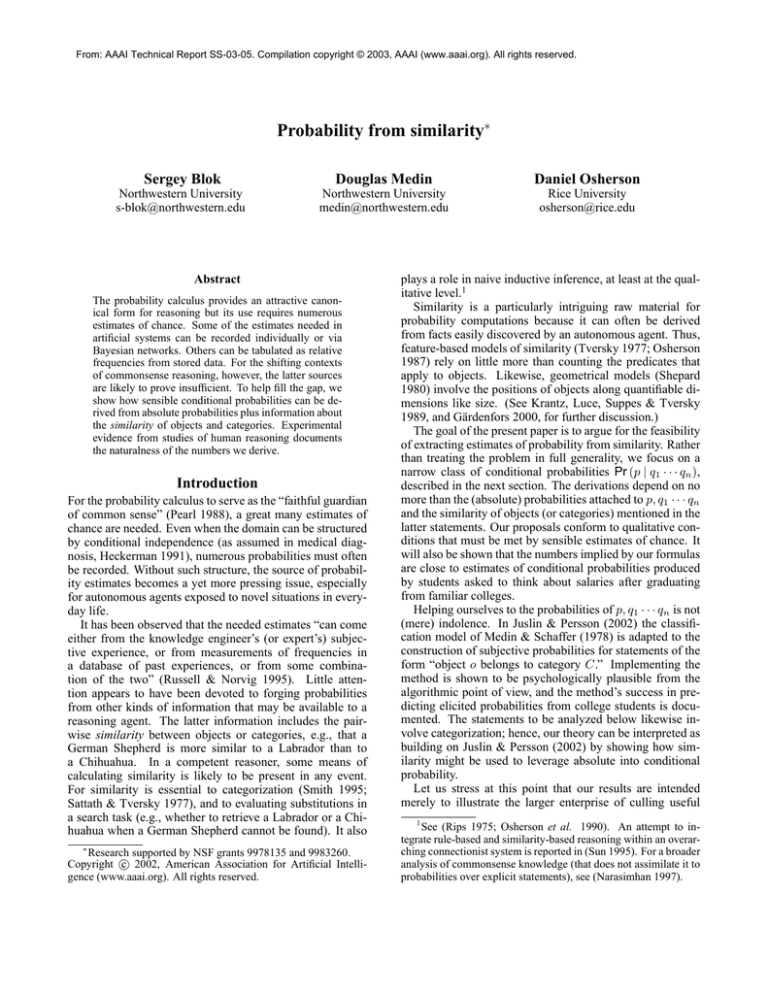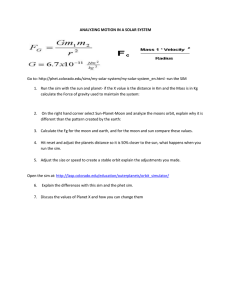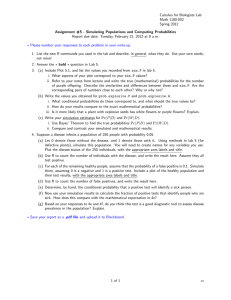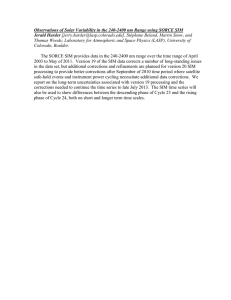
From: AAAI Technical Report SS-03-05. Compilation copyright © 2003, AAAI (www.aaai.org). All rights reserved.
Probability from similarity∗
Sergey Blok
Douglas Medin
Daniel Osherson
Northwestern University
s-blok@northwestern.edu
Northwestern University
medin@northwestern.edu
Rice University
osherson@rice.edu
Abstract
The probability calculus provides an attractive canonical form for reasoning but its use requires numerous
estimates of chance. Some of the estimates needed in
artificial systems can be recorded individually or via
Bayesian networks. Others can be tabulated as relative
frequencies from stored data. For the shifting contexts
of commonsense reasoning, however, the latter sources
are likely to prove insufficient. To help fill the gap, we
show how sensible conditional probabilities can be derived from absolute probabilities plus information about
the similarity of objects and categories. Experimental
evidence from studies of human reasoning documents
the naturalness of the numbers we derive.
Introduction
For the probability calculus to serve as the “faithful guardian
of common sense” (Pearl 1988), a great many estimates of
chance are needed. Even when the domain can be structured
by conditional independence (as assumed in medical diagnosis, Heckerman 1991), numerous probabilities must often
be recorded. Without such structure, the source of probability estimates becomes a yet more pressing issue, especially
for autonomous agents exposed to novel situations in everyday life.
It has been observed that the needed estimates “can come
either from the knowledge engineer’s (or expert’s) subjective experience, or from measurements of frequencies in
a database of past experiences, or from some combination of the two” (Russell & Norvig 1995). Little attention appears to have been devoted to forging probabilities
from other kinds of information that may be available to a
reasoning agent. The latter information includes the pairwise similarity between objects or categories, e.g., that a
German Shepherd is more similar to a Labrador than to
a Chihuahua. In a competent reasoner, some means of
calculating similarity is likely to be present in any event.
For similarity is essential to categorization (Smith 1995;
Sattath & Tversky 1977), and to evaluating substitutions in
a search task (e.g., whether to retrieve a Labrador or a Chihuahua when a German Shepherd cannot be found). It also
∗
Research supported by NSF grants 9978135 and 9983260.
c 2002, American Association for Artificial IntelliCopyright gence (www.aaai.org). All rights reserved.
plays a role in naive inductive inference, at least at the qualitative level.1
Similarity is a particularly intriguing raw material for
probability computations because it can often be derived
from facts easily discovered by an autonomous agent. Thus,
feature-based models of similarity (Tversky 1977; Osherson
1987) rely on little more than counting the predicates that
apply to objects. Likewise, geometrical models (Shepard
1980) involve the positions of objects along quantifiable dimensions like size. (See Krantz, Luce, Suppes & Tversky
1989, and Gärdenfors 2000, for further discussion.)
The goal of the present paper is to argue for the feasibility
of extracting estimates of probability from similarity. Rather
than treating the problem in full generality, we focus on a
narrow class of conditional probabilities Pr (p | q1 · · · qn ),
described in the next section. The derivations depend on no
more than the (absolute) probabilities attached to p, q1 · · · qn
and the similarity of objects (or categories) mentioned in the
latter statements. Our proposals conform to qualitative conditions that must be met by sensible estimates of chance. It
will also be shown that the numbers implied by our formulas
are close to estimates of conditional probabilities produced
by students asked to think about salaries after graduating
from familiar colleges.
Helping ourselves to the probabilities of p, q1 · · · qn is not
(mere) indolence. In Juslin & Persson (2002) the classification model of Medin & Schaffer (1978) is adapted to the
construction of subjective probabilities for statements of the
form “object o belongs to category C.” Implementing the
method is shown to be psychologically plausible from the
algorithmic point of view, and the method’s success in predicting elicited probabilities from college students is documented. The statements to be analyzed below likewise involve categorization; hence, our theory can be interpreted as
building on Juslin & Persson (2002) by showing how similarity might be used to leverage absolute into conditional
probability.
Let us stress at this point that our results are intended
merely to illustrate the larger enterprise of culling useful
1
See (Rips 1975; Osherson et al. 1990). An attempt to integrate rule-based and similarity-based reasoning within an overarching connectionist system is reported in (Sun 1995). For a broader
analysis of commonsense knowledge (that does not assimilate it to
probabilities over explicit statements), see (Narasimhan 1997).
probabilities from varied information available to the reasoner. Similarity is only one type of information that ultimately influences human estimates of chance.2
We conclude this introductory section with a remark about
probabilistic coherence. An agent may endorse Pr (p ∧ q ∧
r) = .5 and Pr (q) = .8 and then use similarity to derive Pr (p | q) = .6. Together, the three judgments are
incoherent in the sense that no joint distribution generates
all three.3 Incoherent probabilities are a questionable basis for reasoning, so a similarity-based estimate of chance
seems to be constrained to take into account the agent’s
pre-existing probabilities. This is a daunting prospect if
the latter set is numerous. It might nonetheless be safe
to generate new probabilities in isolation from earlier ones
if there is an efficient way to “rectify” all the estimates
in a second step, minimally adjusting them to achieve coherence. In fact, recent progress (Batsell et al. 2002;
Deines et al. 2002) in devising algorithms for rectifying incoherent judgment warrants exploring the two step strategy
for expanding a corpus of probabilistic beliefs by similarityderived estimates of chance. We proceed on this basis, thus
ignoring most of the probability corpus already available to
the reasoner prior to her exploitation of similarity.
Theory
First we specify the class of conditional probabilities to be
derived. Then we present and discuss formulas for carrying
out the derivation.
Cases to be considered
Let Q represent a given predicate like “has trichromatic vision.” Letters a, b, c stand for objects or categories to which
Q can be meaningfully applied, e.g., foxes, wolves, goldfish. We assume that a, b, c are all at the same conceptual/hierarchical level. Thus, if a is foxes then b cannot be
a particular fox nor the class of canines. The intent of this
requirement is to allow similarity to be naturally assessed
among all pairs from a, b, c. The statements figuring in our
analysis have the form Qk or ¬Qk, where k is one of a, b, c.
We consider the following types of conditional probabilities.
(1) Conditional probabilities to be derived
(a)
(b)
(c)
(d)
(e)
(f)
(g)
(h)
(i)
(j)
Pr (Qc | Qa)
Pr (Qc | ¬Qa)
Pr (¬Qc | Qa)
Pr (¬Qc | ¬Qa)
Pr (Qc | Qa, Qb)
Pr (¬Qc | ¬Qa, ¬Qb)
Pr (¬Qc | Qa, Qb)
Pr (Qc | ¬Qa, ¬Qb)
Pr (Qc | ¬Qa, Qb) and Pr (Qc | Qa, ¬Qb)
Pr (¬Qc | ¬Qa, Qb) and Pr (¬Qc | Qa, ¬Qb)
2
Obviously, causal theories are also central to commonsense
reasoning. See (Ortiz 1999; Turner 1999).
3
They imply that Pr (p ∧ q) = Pr (q) × (Pr (p ∧ q))/Pr (q) =
Pr (q) × Pr (p | q) = .8 × .6 = .48 < .5 = Pr (p ∧ q ∧ r). No
distribution assigns lower probability to p ∧ q than to p ∧ q ∧ r.
To predict the conditional probabilities in (1), we allow
ourselves no more than (i) the probability of each of the
three statements Qa, Qb, Qc, and (ii) the pairwise similarities among each pair in {a, b, c}. We denote the similarity between objects x, y by sim(x, y), and assume that it is
scaled on the unit interval with 1 representing identity. That
is, sim(x, y) ∈ [0, 1] and sim(x, y) = 1 iff x = y. It is
further assumed that sim is a symmetric function, that is,
sim(x, y) = sim(y, x). The symmetry assumption is consistent with the bulk of human judgment (Aguilar & Medin
1999) even though it may be violated in rare circumstances
(Tversky 1977). The symmetry of sim(· , ·) ensures that
similarity is not a disguised judgment of conditional probability inasmuch as Pr (·| ·) is not symmetric in its arguments.
For any pair of statements p, q, at least one of Pr (p | q) ≥
Pr (p) and Pr (p | ¬q) ≥ Pr (p) must hold. It simplifies notation to assume:
(2) Confirmation Assumption: Pr (Qc | Qa)
Pr (Qc) and Pr (Qc | Qb) ≥ Pr (Qc).
≥
The stimuli used in our experiments have been designed to
satisfy (2). Their construction was guided by the authors’
intuition rather than theory, however. We return to this theoretical gap in the discussion section.
Formulas
The appendix lists the formulas used to construct the conditional probabilities in (1). If the formulas seem complex,
the reader is warmly invited to simplify them in a way compatible with the qualitative conditions of “reasonableness”
discussed next. In fact, we only discuss cases (1)(a),(e),(i).
The others are straightforward variants.
Pr (Qc | Qa). Any formula for constructing Pr (Qc | Qa)
on the basis of Pr (Qa), Pr (Qc) and sim(a, c) should meet
certain qualitative conditions. Trivially, the formula must
ensure that 0 ≤ Pr (Qc | Qa) ≤ 1. More substantively,
as sim(a, c) approaches 1, Pr (Qc | Qa) should approach 1.
For if sim(a, c) ≈ 1 then Pr (Qc | Qa) ≈ Pr (Qc | Qc) = 1.
(Thus, the conditional probability that pigs have trichromatic vision given that the hogs do is close to unity given
the similarity of these creatures.) On the other hand, as
sim(a, c) goes to 0, Pr (Qc | Qa) should go to Pr (Qc). This
is because sim(a, c) ≈ 0 signals the unrelatedness of a and
c, rendering Qa irrelevant to the estimation of Qc. Further
conditions arise from purely probabilistic considerations.
For example, Pr (Qa) ≈ 1 should imply Pr (Qc | Qa) ≈
Pr (Qc). (Consider the probability that newborn rats typically weigh at least one ounce assuming that the same is true
for newborn elephants.) Conversely, and other things equal,
as Pr (Qa) decreases Pr (Qc | Qa) should increase. The formula must also respect the familiar fact that as Pr (Qc) goes
to unity so does Pr (Qc | Qa), and similarly for zero.
It is easy to verify that Formula (4) of the appendix meets
the foregoing conditions. For example, as sim(a, c) goes to
1,
1 − sim(a, c)
1 + sim(a, c)
goes to 0, hence
1−Pr(Qa)
1 − sim(a, c)
1 + sim(a, c)
α
goes to 0, so Pr (Qc) goes to 1. Of course, (4) is not unique
with these properties, but it is the simplest formula that occurred to us, and reaches its limiting behavior monotonically. It will be seen in the next section that (4) provides
a reasonable approximation to Pr (Qc | Qa) in at least one
experimental context.
Note that Formula (4) satisfies the Confirmation Assumption (2) inasmuch as Pr (Qc) cannot exceed Pr (Qc | Qa).
α=
Pr (Qc | Qa, Qb). We propose ten qualitative conditions
that should be satisfied by a formula for Pr (Qc | Qa, Qb);
five involve similarity and are discussed first. As either
sim(a, c) or sim(b, c) approach unity, Pr (Qc | Qa, Qb)
should also approach unity. (Thus, the conditional probability that pigs have trichromatic vision given that the hogs
and squirrels do is close to unity given the similarity of
pigs and hogs.) Next, if both sim(a, c) and sim(b, c) go to
0 then Pr (Qc | Qa, Qb) should go to Pr (Qc) (since zero
similarity signals irrelevance of the conditioning events).
On the other hand, if just sim(a, c) approaches 0, then
Pr (Qc | Qa, Qb) should approach Pr (Qc | Qb); likewise,
if just sim(b, c) approaches 0 then Pr (Qc | Qa, Qb) should
approach Pr (Qc | Qa). (Thus, the probability that wolves
are fond of garlic given that bears and bees are is close to the
probability that wolves are fond of garlic given than bears
are.) Next, as sim(a, b) goes to unity, Pr (Qc | Qa, Qb)
should go to Pr (Qc | Qa) [equivalently, Pr (Qc | Qa, Qb)
should go to Pr (Qc | Qb)]. For sim(a, b) ≈ 1 indicates
that Qa, Qb record virtually identical facts. (Thus, the
probability that otters can hear ultrasounds given that porpoises and dolphins can should be close to the probability that otters can hear ultrasounds given that porpoises
can.) Our formula also represents the converse tendency
when neither similarities nor absolute probabilities are extreme. In this case, we typically expect Pr (Qc | Qa, Qb) >
Pr (Qc | Qa), Pr (Qc | Qb). (Thus, the probability that
geese have a magnetic sense given that sparrows and eagles
do exceeds the probability that geese have a magnetic sense
given that sparrows do, without reference to eagles.) Naturally, there are counterexamples to such generalizations;
they will be discussed at the end.
Purely probabilistic conditions on the construction of
Pr (Qc | Qa, Qb) include the following.
(a) 0 ≤ Pr (Qc | Qa, Qb) ≤ 1.
(b) As Pr (Qa) approaches unity, Pr (Qc | Qa, Qb)
approaches Pr (Qc | Qb). Likewise, as Pr (Qb)
approaches unity, Pr (Qc | Qa, Qb) approaches
Pr (Qc | Qa).
(c) As Pr (Qa) and Pr (Qb) both go to unity,
Pr (Qc | Qa, Qb) goes to Pr (Qc).
(d) Other things equal, as Pr (Qa) and Pr (Qb) both
decrease, Pr (Qc | Qa, Qb) increases.
(e) As Pr (Qc) approaches unity, so does
Pr (Qc | Qa, Qb);
as Pr (Qc) approaches
zero, so does Pr (Qc | Qa, Qb).
Formula (8) satisfies all the conditions we
have posited for Pr (Qc | Qa, Qb).
For example, if sim(a, b) ≈ 1 then β ≈ 1 in (8), hence
Pr (Qc | Qa)
≈
max{Pr (Qc | Qa), Pr (Qc | Qb)}.
Since sim(a, b) ≈ 1, the latter expression is close to
max{Pr (Qc | Qa), Pr (Qc | Qa)} = Pr (Qc | Qa).
Pr (Qc | ¬Qa, Qb). Note first that (2) implies that
Pr (Qc | Qb) ≥ Pr (Qc).
It also follows that
Pr (Qc | ¬Qa) ≤ Pr (Qc). In light of these inequalities, four constraints on the relation between similarity and Pr (Qc | ¬Qa, Qb) may be formulated. First, as
sim(a, c) approaches unity, Pr (Qc | ¬Qa, Qb) approaches
zero. Likewise, as sim(b, c) approaches unity, so does
Pr (Qc | ¬Qa, Qb). [Of course, by the transitivity of
identity and Leibniz’s law, it can’t be the case that
both sim(a, c) and sim(b, c) approach unity.] Next, as
sim(a, c) and sim(b, c) both go to zero, Pr (Qc | ¬Qa, Qb)
goes to Pr (Qc). Finally, if just sim(a, c) goes to zero
then Pr (Qc | ¬Qa, Qb) goes to Pr (Qc | Qb); likewise,
if sim(b, c) goes to zero then Pr (Qc | ¬Qa, Qb) goes to
Pr (Qc | ¬Qa).
We also have familiar conditions involving only probability. As Pr (Qa) approaches zero, Pr (Qc | ¬Qa, Qb)
approaches Pr (Qc | Qb); likewise, as Pr (Qb) approaches
1, Pr (Qc | ¬Qa, Qb) approaches Pr (Qc | ¬Qa). In the
same way, as Pr (Qa) approaches zero while Pr (Qb)
approaches unity, Pr (Qc | ¬Qa, Qb) approaches Pr (Qc).
And as Pr (Qc) goes to unity (respectively, to zero), so does
Pr (Qc | ¬Qa, Qb).
Formula (12) satisfies the foregoing conditions. For
example, sim(a, c) ≈ 1 implies that X is large relative to Y , hence that Pr (Qc | ¬Qa, Qb) is dominated by
Pr (Qc | ¬Qa).
Pr (Qc | Qa, ¬Qb) is treated in parallel fashion.
Experimental test of the theory
Three experiments were performed to assess the psychological plausibility of our formulas. The vast array of potential
predicates and objects renders definitive evaluation a long
range project. As a preliminary test, we chose a domain
about which college students were likely to have opinions
and interest, namely, post-graduation salaries from different
colleges and universities.
Experiment 1
Stimuli and procedure. The following institutions served
as objects in the first experiment (playing the roles of a, b, c
in the theoretical section above.
Connecticut State University
Oklahoma State University
Harvard University
Arkansas State University
Yale University
The predicate employed was:
over 60% of the graduates from [a given institution]
will earn more than $50,000 a year at their first job.
The resulting five statements give rise to 20 conditional
probabilities of form (1)(a) [Pr (Qc | Qa)] and to 60 of form
(1)(e) [Pr (Qc | Qa, Qb)].4 Eighteen students at Northwestern University were recruited to evaluate probabilities and
similarities. Each student estimated all 20 conditional probabilities of the first form, and half of the second form (50
judgments in all). In addition, each student estimated the
(absolute) probabilities of the five statements, as well as the
10 similarities among the five institutions. Similarity was
rated on a scale from 0 (perfect dissimilarity) to 1 (perfect
similarity). Observe that 15 judgments of similarity and absolute probability were used to predict 80 judgments of conditional probability (or 50 judgments if the order of conditioning events is ignored). The predictions were made on the
basis of formulas (4) and (8) of the appendix.
Data were collected using a computerized questionnaire.
Similarity judgments were elicited first, followed by absolute probabilities, conditional probabilities of form (1)(a)
then conditional probabilities of form (1)(e). Within these
categories, stimuli were individually randomized.
Results. Data were averaged prior to analysis. Probabilities of form (1)(e) are thus the average of estimates by 9
students; all other averages involve 18 students.5 We computed three linear correlations, namely:
(3) Correlations computed
(a) between the conditional probabilities of form
(1)(a) versus their predicted values using Formula (4);
(b) between the conditional probabilities of form
(1)(e) versus their predicted values using Formula (8); and
(c) between the conditional probabilities of both
forms (1)(a) and (1)(e) versus their predicted values using Formulas (4) and (8).
Correlation (3)(c) is plotted in Figure 1, and reveals good
fit between predicted and observed values. Note that the regression line does not lie precisely along the diagonal. This
disparity seems inevitable given the arbitrary endpoints of
the similarity scale, which may not be coterminous with the
probability interval in the minds of human judges. The correlation for (3)(a) is .99 (N = 20). For (3)(b) it is .92
(N = 60).
Experiment 2
Stimuli and procedure. The following four institutions
served as objects in the second experiment.
Harvard University
Harvard Divinity School
4
Texas Technical Institute
Texas Bible College
We distinguish the order of two conditioning events
[otherwise, there would be only 30 probabilities of form
Pr (Qc | Qa, Qb) based on 5 statements]. The order in which information is presented is an important variable in many reasoning
contexts (Johnson-Laird 1983) although there is little impact in the
present study.
5
Student-by-student analyses of the data are reported in Blok
(2003).
Results
for
Pr (Qc | Qa)
and
Pr (Qc | Qa, Qb).
Correlation = .93 (N = 80). Slope = 1.13, Intercept = .099.
Figure 1: Correlations in Experiment 1
Two predicates were employed:
• graduates [of a given institution] earned an average salary
of more than $50,000 a year in their first job after graduation.
• graduates [of a given institution] earned an average salary
of less than $50,000 a year in their first job after graduation.
We conceived the second predicate as the negation of the
first (ignoring the case of equal salaries). The resulting statements give rise to twelve conditional probabilities
of form (1)(a) [Pr (Qc | Qa)] and twelve of form (1)(b)
[Pr (Qc | ¬Qa)]. Forty-one students at Northwestern University evaluated these 24 conditional probabilities along
with the similarities and absolute probabilities needed to test
formulas (4) and (5). Data collection proceeded as in Experiment 1.
Results. Data were averaged over the 41 students. Figure
2 shows the correlation between the conditional probabilities
of forms (1)(a) and (1)(b) versus their predicted values using
Formulas (4) and (5). The correlation for the 12 probabilities
of form Pr (Qc | Qa) is .98; for Pr (Qc | ¬Qa) it is .91.
Experiment 3
The stimuli of Experiment 2 also served in Experiment
3. The resulting statements give rise to 96 conditional
probabilities of forms (1)(e) [Pr (Qc | Qa, Qb)], (1)(h)
[Pr (Qc | ¬Qa, ¬Qb)]. and (1)(i) [Pr (Qc | ¬Qa, Qb) and
Pr (Qc | Qa, ¬Qb)]. Forty-seven students at Northwestern
University each evaluated half of these conditional probabilities, along with the six similarities and eight absolute probabilities needed to test formulas (8), (11) and (12). Each of
the 96 conditional probabilities was thus evaluated by 23 or
24 students. Data were collected in the same order as for
Experiments 1 and 2. Note that in the present experiment 14
judgments of similarity and absolute probability are used to
predict 96 judgments of conditional probability.
Figure 3 shows the correlation between the conditional probabilities of forms (1)(e),(h),(i) versus their pre-
Results for Pr (Qc | Qa) and Pr (Qc | ¬Qa). Correlation =
.95 (N = 24). Slope = .922, Intercept = .053.
Figure 2: Correlation in Experiment 2
Results for Pr (Qc | Qa, Qb),
Pr (Qc | ¬Qa, ¬Qb),
Pr (Qc | ¬Qa, Qb) and
Pr (Qc | Qa, ¬Qb).
Correlation = .91 (N = 96).
Slope = .893, Intercept = .042.
Figure 3: Correlation in Experiment 3
dicted values using Formulas (8), (11), and (12). For
Pr (Qc | Qa, Qb) the correlation is .93 (N = 24). For
Pr (Qc | ¬Qa, ¬Qb) it is .92 (N = 24), whereas for
Pr (Qc | ¬Qa, Qb) and Pr (Qc | Qa, ¬Qb) it is .93 (N =
48).
Discussion
Our experimental results illustrate the thesis that sensible estimates of chance can be extracted from nonprobabilistic information that may be available to reasoning agents for other
purposes. In the present case, conditional probabilities are
derived from similarity supplemented with absolute probability. The specific proposals embodied in formulas (4) (13) should be considered tentative and preliminary.
Of particular importance to developing our theory is the
context-dependent nature of similarity, often noted in psychology (Keil et al. 1998; Osherson, Smith, & Shafir 1986;
Medin, Goldstone, & Gentner 1993). Thus, the similarity
of the Texas Technical Institute to the Texas Bible College
should depend on the content of the statements whose probabilities are at issue (e.g., involving geography versus curriculum). Similarity is usually calculated on the basis of
shared features or proximity in a feature space (as noted
earlier). The context-dependence of similarity thus requires
that some features be counted as more relevant than others,
depending on which predicate Q is involved in the probability to be estimated. The issue of relevance is much
discussed in philosophy and A.I. (Blum & Langley 1997;
Goodman 1972). For present purposes, it may suffice to
measure relevance in terms of path-length in an ontological
hierarchy of predicates. Alternatively, two predicates might
be considered mutually relevant to the extent that they covary in their application to objects familiar to the reasoner.
Constructing Pr (Qc | Qa) would thus proceed by first calculating the relevance of predicates to Q, next calculating
sim(a, c) on the basis of weighted features or dimensions,
then applying rule (4).6
In addition to relevance, there is another type of information that needs to be accessed prior to applying our formulas. To calculate Pr (Qc | Qa), for example, it is necessary
to know whether Qa confirms or disconfirms Qc. Suppose
that a is Dell Computer Corporation, and c is HP/Compaq.
If Q is increases sales next year then Qa will strike many
reasoners as confirmatory of Qc, whereas if Q is increases
market share next year then Qa will seem disconfirmatory
of Qc. The similarity of a and c can be expected to have
different effects in the two cases. To simplify the issue, we
constructed stimuli that satisfy the confirmation assumption
(2), thereby aligning polarity with confirmation; specifically,
one of our experimental statements confirms another just
in case both have the same number of negation signs. For
greater generality, the computation of Pr (Qc | Qa) should
proceed on the basis of (4) if Qa confirms Qc, but on the
basis of a formula like (5) if Qa disconfirms Qc [and similarly for the other forms listed in (1)]. Default assumptions
governing large sets of objects and predicates might suffice
in many cases. For example, susceptibility to disease may
normally be assumed to extend to species of the same genus
and rarely beyond (Coley, Atran, & Medin 1997). Exceptions to such rules need to be marked in memory. Marked
cases can be expected to include a range of special facts that
resist convenient classification. Even the similarity of identical twins (which usually underwrites high probability of
matching features) can be trumped by information that just
one of them is dating a millionaire.
Finally, we note that the theory discussed in the present
paper can be extended to a broader class of probabilities,
beyond those listed in (1). For example, the probability
of universal statements is treated in Blok (2003). The theory can also be generalized to conditional probabilities like
Pr (Qc | Ra), involving different predicates in the conditioning and target events. For this purpose, similarity must
be assessed between pairs of predicates.
6
For further discussion of similarity, relevance, and induction,
see (Medin et al. 2003). That similarity involves more than just
counting features is shown in (Lassaline 1996).
Appendix: Formulas for predicting
conditional probability
(4) Pr (Qc | Qa) = Pr (Qc)α , where
1−Pr(Qa)
1 − sim(a, c)
α=
.
1 + sim(a, c)
(5) Pr (Qc | ¬Qa) = 1.0 − (1.0 − Pr (Qc))α , where
Pr(Qa)
1 − sim(a, c)
α=
.
1 + sim(a, c)
and Pr (¬Qc | ¬Qa) and Pr (¬Qc | ¬Qb) are defined by
Equation (7).
(19) Pr (¬Qc | Qa, Qb) = βM + (1 − β)S, where
sim(a, b)
sim(a, c)
sim(b, c)
1.0 − sim(a, c)
β = max
,
1.0
−
sim(b,
c)
Pr (Qa)
Pr (Qb)
M = max{Pr (¬Qc | Qa), Pr (¬Qc | Qb)}, S =
Pr (¬Qc | Qa) + Pr (¬Qc | Qb)−
(6) Pr (¬Qc | Qa) = 1.0 − Pr (Qc)α , where
1−Pr(Qa)
1 − sim(a, c)
α=
.
1 + sim(a, c)
(7) Pr (¬Qc | ¬Qa) = (1.0 − Pr (Qc))α , where
Pr(Qa)
1 − sim(a, c)
α=
.
1 + sim(a, c)
(8) Pr (Qc | Qa, Qb) = βM + (1 − β)S, where
sim(a, b)
sim(a, c)
sim(b, c)
1.0 − sim(a, c)
β = max
,
1.0
−
sim(b,
c)
Pr (Qa)
Pr (Qb)
M = max{Pr (Qc | Qa), Pr (Qc | Qb)}, S =
Pr (Qc | Qa)+Pr (Qc | Qb)− Pr (Qc | Qa)×Pr (Qc | Qb),
and Pr (Qc | Qa) and Pr (Qc | Qb) are defined by Equation
(4).
Pr (¬Qc | Qa) × Pr (¬Qc | Qb),
and Pr (¬Qc | Qa) and Pr (¬Qc | Qb) are defined by Equation (6).
(11) Pr (Qc | ¬Qa, ¬Qb) = βM + (1 − β)S, where
sim(a, b)
sim(a, c)
sim(b, c)
1.0 − sim(a, c)
β = max
,
1.0
−
sim(b,
c)
1.0 − Pr (Qa)
1.0 − Pr (Qb)
M = max{Pr (Qc | ¬Qa), Pr (Qc | ¬Qb)}, S =
Pr (Qc | ¬Qa) + Pr (Qc | ¬Qb)−
Pr (Qc | ¬Qa) × Pr (Qc | ¬Qb),
and Pr (Qc | ¬Qa) and Pr (Qc | ¬Qb) are defined by Equation (5).
(12) Pr (Qc | ¬Qa, Qb) =
Y
X
+ Pr (Qc | Qb) ×
Pr (Qc | ¬Qa) ×
X +Y
X +Y
where
sim(a, c)
× Pr (Qa)
1 − sim(a, c)
sim(b, c)
Y =
× [1.0 − Pr (Qb)],
1 − sim(b, c)
and Pr (Qc | ¬Qa) and Pr (Qc | Qb) are defined by Equations (5) and (4), respectively.
X=
(9) Pr (¬Qc | ¬Qa, ¬Qb) = βM + (1 − β)S, where
sim(a, b)
sim(a, c)
sim(b, c)
1.0 − sim(a, c)
,
β = max
1.0
−
sim(b,
c)
1.0 − Pr (Qa)
1.0 − Pr (Qb)
M = max{Pr (¬Qc | ¬Qa), Pr (¬Qc | ¬Qb)}, S =
Pr (¬Qc | ¬Qa) + Pr (¬Qc | ¬Qb)−
Pr (¬Qc | ¬Qa) × Pr (¬Qc | ¬Qb),
(13) Pr (¬Qc | ¬Qa, Qb) =
Pr (¬Qc | ¬Qa) ×
X
X +Y
Y
+ Pr (¬Qc | Qb) ×
X +Y
where
sim(a, c)
× Pr (Qa)
1 − sim(a, c)
sim(b, c)
Y =
× [1.0 − Pr (Qb)],
1 − sim(b, c)
X=
and Pr (¬Qc | ¬Qa) and Pr (¬Qc | Qb) are defined by
Equations (7) and (6), respectively.
References
Aguilar, C. M., and Medin, D. L. 1999. Asymmetries of
comparison. Psychonomic Bulletin & Review 6:328–337.
Batsell, R.; Brenner, L.; Osherson, D.; Tsavachidis, S.; and
Vardi, M. Y. 2002. Eliminating incoherence from subjective estimates of chance. In Proceedings of the 8th International Conference on the Principles of Knowledge Representation and Reasoning (KR 2002).
Blok, S. 2003. Probability intuitions derived from judgments of similarity. Ph.D. Dissertation, Northwestern University.
Blum, A. L., and Langley, P. 1997. Selection of relevant
features and examples in machine learning. Artificial Intelligence 97:245–271.
Coley, J. D.; Atran, S.; and Medin, D. L. 1997. Does rank
have its privilege? inductive inference within folk biological taxonomies. Cognition 64:73–112.
Deines, J.; Osherson, D.; Thompson, J.; Tsavachidis, S.;
and Vardi, M. Y. 2002. Removing incoherence from subjective estimates of chance. Submitted.
Gärdenfors, P. 2000. Conceptual Spaces: The Geometry of
Thought. Cambridge MA: MIT Press.
Goodman, N. 1972. Seven strictures on similarity. In
Problems and projects. New York NY: Bobbs-Merrill.
Heckerman, D. 1991. Probabilistic Similarity Networks.
Cambridge MA: MIT Press.
Johnson-Laird, P. N. 1983. Mental Models. Cambridge
MA: Harvard University Press.
Juslin, P., and Persson, M. 2002. PROBabilities from
EXemplars (PROBEX): a ‘lazy’ algorithm for probabilistic inference from generic knowledge. Cognitive Science
26:563–607.
Keil, F.; Smith, W. C.; Simons, D. J.; and Levin, D. T.
1998. Two dogmas of conceptual empiricism: implications
for hybrid models of the structure of knowledge. Cognition
65:103 – 135.
Krantz, D. H.; Luce, R. D.; Suppes, P.; and Tversky, A.
1989. Foundations of Measurement, Volume II. New York
NY: Academic Press.
Lassaline, M. E. 1996. Structural alignment in induction and similarity. Journal of Experimental Psychology:
Learning, Memory and Cognition 22:754–770.
Medin, D. L., and Schaffer, M. M. 1978. Context model of
classification learning. Psychological Review 85:207–238.
Medin, D. L.; Coley, J. D.; Storms, G.; and Hayes, B. K.
2003. A relevance theory of induction. Psychonomic Bulletin & Review (in press).
Medin, D. L.; Goldstone, R. L.; and Gentner, D. 1993.
Respects for similarity. Psychological Review 100:254–
278.
Narasimhan, R. 1997. Knowledge processing and commonsense. Knowledge-Based Systems 10(3):147–151.
Ortiz, C. L. 1999. A commonsense language for reasoning
about causation and rational action. Artificial Intelligence
111:73–130.
Osherson, D.; Smith, E. E.; Wilkie, O.; López, A.; and
Shafir, E. 1990. Category Based Induction. Psychological
Review 97(2):185–200.
Osherson, D.; Smith, E. E.; and Shafir, E. 1986. Some
origins of belief. Cognition 24:197–224.
Osherson, D. 1987. New axioms for the contrast model of
similarity. Journal of Mathematical Psychology 93–103.
Pearl, J. 1988. Probabilistic Reasoning in Intelligent Systems. San Mateo, CA: Morgan Kaufamann.
Rips, L. 1975. Inductive judgments about natural categories. Journal of Verbal Learning and Verbal Behavior
14:665–681.
Russell, S. J., and Norvig, P. 1995. Artificial Intelligence:
A Modern Approach. Upper Saddle River NJ: Prentice
Hall.
Sattath, S., and Tversky, A. 1977. Additive Similarity
Trees. Psychometrika 42(3):319–345.
Shepard, R. N. 1980. Multidimensional scaling, treefitting, and clustering. Science 390–398.
Smith, E. E. 1995. Concepts and Categorization. In Smith,
E., and Osherson, D., eds., Invitation to Cognitive Science:
Thinking (2nd Edition). Cambridge MA: M.I.T. Press.
Sun, R. 1995. Robust reasoning: integrating rule-based and
similarity-based reasoning. Artificial Intelligence 75:241–
295.
Turner, H. 1999. A logic of universal causation. Artificial
Intelligence 113:87–123.
Tversky, A. 1977. Features of Similarity. Psychological
Review 84:327–352.






